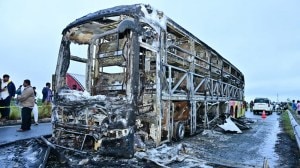The last of London’s dons depart, thousands line up to say goodbye
LONDON, OCTOBER 11: Thousands of people lined the streets of East London today to witness the funeral procession of Reggie Kray, the last ...

LONDON, OCTOBER 11: Thousands of people lined the streets of East London today to witness the funeral procession of Reggie Kray, the last of a family of gangsters which terrorised London in the 1960s. Many in the crowd applauded, and some wept as the glass-sided Victorian hearse drawn by six black plumed horses went by bearing the coffin and wreaths which proclaimed `Free At Last’.
Among the mourners were celebrities like actor Steven Berkoff and the soap-opera queen Barbara Castle. Reggie Kray, along with his psychopathic twin, Ronnie and older brother Charlie, were `The Krays’, East End versions of Chicago gangsters who became the most feared criminals in 60s Britain.
They were kings of protection rackets which they maintained through fear and violence. But, in their time the sharp-suited Krays, photographed by society snapper David Bailey, enjoyed a bizarre celebrity status brushing shoulders with film stars Judy Garland and Diana Dors, and counting among their friends at least one peer of the realm.
Reggie and Ronnie were identical twins born in 1933 and raised in the East End of London. They had some success as amateur boxers and did national service in the army, although they spent most of this time locked up for beating up NCOs or going AWOL.
Returning to the East End they set up a protection racket, collecting money by threats, from shopkeepers. Ronnie’s `volatile’ temper was a useful tool in spreading fear, so necessary to this business. Their reputation as primo uno thugs was established in 1954, when Ronnie cutlassed members of a Maltese gang that tried to extract protection money from them at the Regal billiard club on the Mile End Road, which they had taken over. Word Spread and the Krays ruled, at least for a while.
Reggie Kray, who died of cancer last week, had spent 30 uninterrupted years in jail for the murder in 1967 of a one-time Kray ally, Jack `The Hat’ McVitie. Ronnie, who was diagnosed as clinically insane also spent his life in jail after being convicted of the murder of small-time criminal George Cornell in the Blind Beggar pub in Whitechapel in 1966 for calling him a “fat poof”, a reference to his purported homosexuality.
The fear the Krays lived by, protected them until the arrival of Scotland Yard detective, Leonard `Nipper’ Read, a man whose reputation for tenacity was such that the Kray twins named their pet boa constrictor after him.
Thirty years spent inside did nothing to diminish the legend of the Krays. In fact, Britain’s bizarre obsession with celebrity criminals helped keep the Kray name alive, with spin offs from films to T-shirts and eventually a website feeding the distorted myth of the glamorous gangster.
In popular mythology, they were `gentleman criminals’, who wore stylish suits and shades, “treated the ladies with respect” and looked after their mother. A campaign to free the brothers, produced a petition signed by 10,000 people as recently as 1993. Their supporters included Barbara Windsor, of the BBC soap EastEnders, Roger Daltrey of The Who, and the actress Patsy Kensit, better known as Oasis star Liam Gallagher’s former wife, and boxer Mike Tyson. The Krays’ supporters argued that they were only guilty of crimes against criminals. The code of honour among this club of criminals rates murder as an acceptable, even necessary, felony for membership, but rape or child abuse as beyond the pale.
More than 30 years after the Krays stepped into the clink, a tearful mourner at today’s funeral pronounced: “East London was a better place when Reg was around, we had none of them paedophiles and the like then.”
A former associate Mad Frankie Fraser said recently: “Everyone in the East End loved the Krays, no woman got mugged, and no children were tampered with.” Tony Lambrianou, an associate who disposed of the body of one of Kray’s murder victims, by throwing it into a car and crushing it into a three foot cube, insisted: “They were not evil men. They done unto those what they would have done to them, and this involved other villains, It’s not an excuse, that’s just facts.”
The myth lives on.





- 01
- 02
- 03
- 04
- 05


























